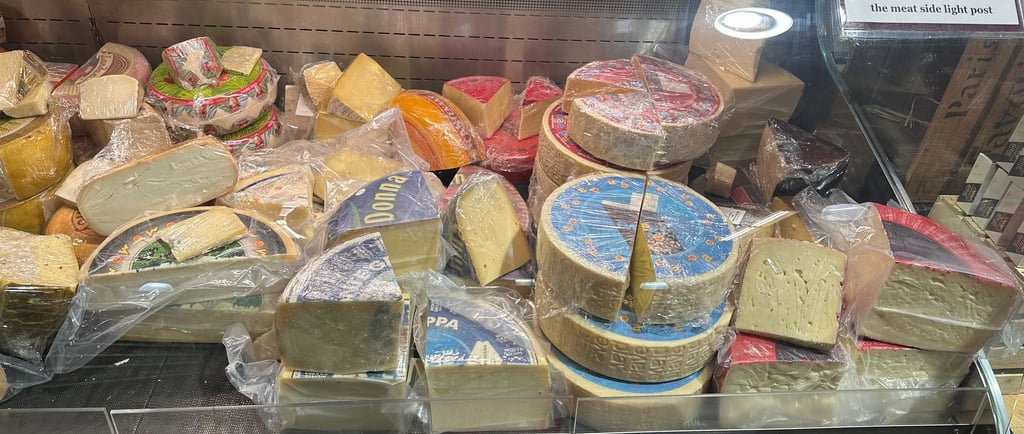How To Store Cheese: A Complete Guide
Learn how to store every type of cheese in this complete guide that includes shelf life, wrapping tips, and more.
CHEESE STORAGE
Ryan Hagen
10/7/20255 min read


🧀 How to store cheese: Keep every variety fresh, flavorful, and safe
Cheese is one of life’s simple pleasures, but it’s also a living, breathing food that changes over time. Knowing how to store different types of cheese properly isn’t just about preventing mold; it’s about preserving their texture, aroma, and flavor. Whether it’s a delicate fresh cheese like burrata or mozzarella, or a sturdy wedge of Parmesan, each type of cheese has its own storage rules.
In this guide, you’ll learn how to store every type of cheese, from soft cheeses to hard cheeses — plus how long each variety lasts in the fridge once opened.
🧊 General cheese storage tips
Before diving into the different cheese types, a few universal storage principles apply across the board:
Avoid airtight plastic wrap: Cheese needs to breathe. Tight plastic traps moisture and can encourage the growth of unwanted mold.
Use breathable paper or wax paper: Wrap cheese loosely in wax paper, parchment, or special cheese paper, then place it in a loose plastic bag or reusable container.
Keep it cool, not cold: Cheese is happiest in the vegetable drawer or cheese drawer, where temperatures are slightly higher (around 40°F / 4°C).
Label your cheese: If you have multiple types, label and date each one. That way, you can keep track of freshness and avoid mystery wedges in the fridge.
How to store fresh cheeses
Fresh cheeses are high in moisture and low in salt, which means they spoil quickly. Examples include mozzarella, burrata, ricotta, goat cheese (also known as chèvre), cream cheese, and cottage cheese.
🧩 How to store them
Keep them refrigerated at all times — between 34°F and 38°F (1°C–3°C).
Store unopened containers as soon as they arrive from the store.
Once opened, transfer leftovers into an airtight container.
If the cheese came in brine or liquid, always keep it submerged to prevent drying out.
For cheeses like burrata or mozzarella, change the brine or water every 1–2 days for optimal freshness. Goat cheese logs can be wrapped in parchment or cheese paper and kept in a sealed container to prevent drying.
🧭 How long fresh cheese lasts in the fridge
How to store soft-ripened cheeses
Soft-ripened cheeses like Brie, Camembert, and triple-cream cheeses have delicate white rinds and creamy interiors that continue aging even after purchase.
🧩 How to store them
Wrap them in cheese paper or wax paper, not plastic wrap.
Store in the vegetable drawer or cheese compartment, ideally between 40°F and 45°F (4°C–7°C).
Keep away from strong-smelling foods; these cheeses absorb odors easily.
If you don’t have cheese paper, wrap Brie cheese, Camembert cheese, and others in parchment, then place them in a loose plastic or beeswax bag to retain moisture.
🧭 How long soft-ripened cheese lasts in the fridge
How to store semi-soft and washed-rind cheeses
Semi-soft and washed-rind cheeses — like Havarti, Fontina, Munster, Taleggio, and Limburger — are a little sturdier but still quite moist and aromatic.
🧩 How to store them
Wrap in wax paper or cheese paper and then loosely in plastic wrap or a reusable silicone bag.
These cheeses tend to be aromatic, so you may want to store them in a dedicated cheese box or container to keep the fridge from absorbing the smell.
Keep the cheese drawer temperature around 38–42°F (3–6°C).
🧭 How long semi-soft cheese lasts in the fridge
How to store semi-hard cheeses
Semi-hard cheeses, such as Cheddar, Gouda, Gruyère, Edam, Jarlsberg, and Manchego, have lower moisture content and last longer than softer cheeses — but they still need care to avoid drying out.
🧩 How to store them
Wrap wedges in wax or cheese paper to let them breathe.
Then, place the wrapped wedge in a resealable bag or an airtight container to maintain its humidity.
Store in the vegetable drawer or on the middle shelf of the fridge, at a temperature of 37–40°F (3–4°C).
Avoid freezing — it alters texture and causes crumbling.
🧭 How long semi-hard cheese lasts in the fridge


How to store hard cheeses
Hard cheeses, such as Parmesan (Parmigiano Reggiano), Pecorino Romano, Asiago, and Grana Padano, are naturally long-lasting due to their low moisture content and dense texture.
🧩 How to store them
Wrap tightly in wax or parchment paper, then cover with aluminum foil or store in a reusable airtight container.
Keep in the cheese or vegetable drawer, around 37°F (3°C).
Avoid direct contact with plastic wrap; it traps moisture and can cause surface mold.
🧭 How long hard cheese lasts in the fridge
How to store blue cheeses
Blue cheeses like Gorgonzola, Roquefort, Stilton, and Bleu d’Auvergne are rich, creamy, and veined with edible mold — but that mold needs the right environment to stay in balance.
🧩 How to store them
Wrap blue cheese in wax paper or foil, not plastic wrap, to prevent suffocating the mold.
Store in a dedicated container or box to contain the strong aroma.
Keep temperature between 38°F and 42°F (3–6°C).
🧭 How long blue cheese lasts in the fridge
Freezing cheese: When (and when not) to do It
Freezing cheese isn’t ideal, but it can work in certain cases — especially for hard and semi-hard cheeses used for cooking. Texture may become crumbly, but flavor stays intact.
Best cheeses to freeze:
Cheddar, Gouda, Monterey Jack, and Parmesan freeze fairly well.
Always grate or cube before freezing for easy use later.
Store in airtight freezer bags for up to 6 months.
Avoid freezing:
Fresh and soft cheeses like ricotta, burrata, brie, or goat cheese. Freezing these cheeses will ruin their texture and taste.
The right way to serve cheese after storage
Before serving, remove cheese from the fridge about 30–60 minutes beforehand. Cheese tastes best at room temperature, when its aromas and textures fully develop.
Avoid leaving cheese out for more than two hours, especially soft or fresh varieties.
Final slice
Knowing how to store cheese properly is the difference between dry, bland wedges and rich, creamy perfection. Each cheese type, from the freshest ricotta to the oldest Parmesan, needs a little attention to maintain its unique flavor and texture.
By using breathable wraps, maintaining steady fridge temperatures, and paying attention to expiration times, you’ll waste less cheese and enjoy every bite at its peak.
How to store cheese FAQ
How to store Parmesan cheese?
Parmesan cheese should be stored tightly wrapped in parchment or wax paper, then placed in an airtight container in the refrigerator. Whole wedges can last several months, while grated Parmesan is best used within 1–2 weeks for optimal flavor. For long-term storage, you can freeze Parmesan for up to six months, though the texture may change slightly.
How to store cheese in fridge?
To store cheese in the fridge, wrap it in wax or parchment paper first, then place it in a loosely sealed container to allow it to breathe while preventing it from drying out. Keep it in the cheese or vegetable drawer, where humidity is higher, and separate different types to avoid flavor transfer. Most cheeses stay fresh for 1–6 weeks, depending on type and age.
How to store mozzarella cheese?
Mozzarella cheese should be stored in its liquid (whey or water) in an airtight container in the refrigerator to maintain its freshness and softness. Consume fresh mozzarella within 3–5 days. For longer storage, you can freeze it for up to 2–3 months, although the texture may change slightly.
How to store feta cheese?
Feta cheese should be stored in its brine in an airtight container in the refrigerator to maintain its moisture and flavor. If it didn’t come in brine, you can make your own by dissolving salt in water. Properly stored, feta can last 1–2 weeks; cutting it into smaller pieces helps maintain its freshness.
How to store shredded cheese?
Shredded cheese should be stored in an airtight container or a resealable bag in the refrigerator to prevent moisture and mold growth. It typically lasts 5–7 days fresh, but you can freeze it for 2–3 months for longer storage; just note that freezing may slightly change the texture.
Cheese Soul
Explore the world of cheese and lifestyle.
© 2025. All rights reserved.
